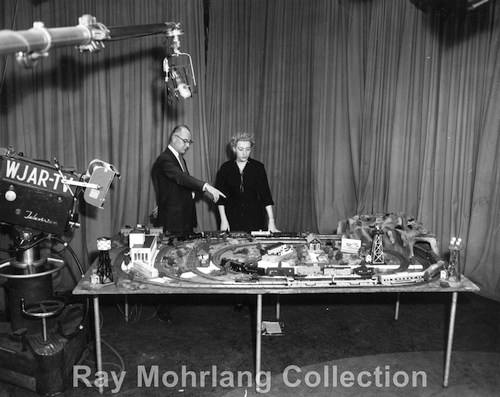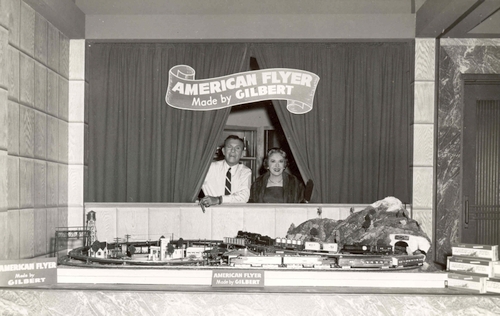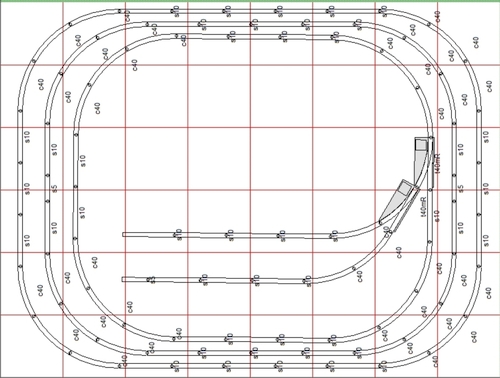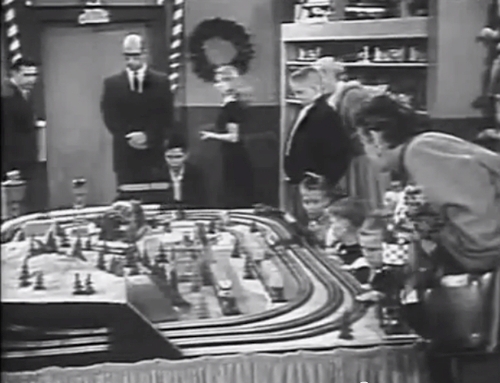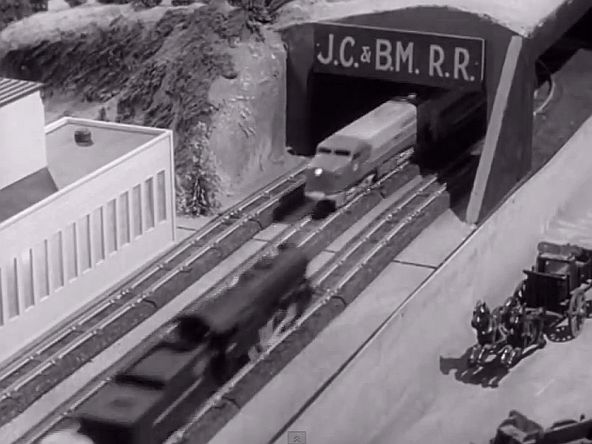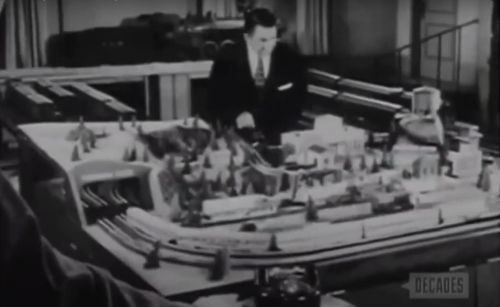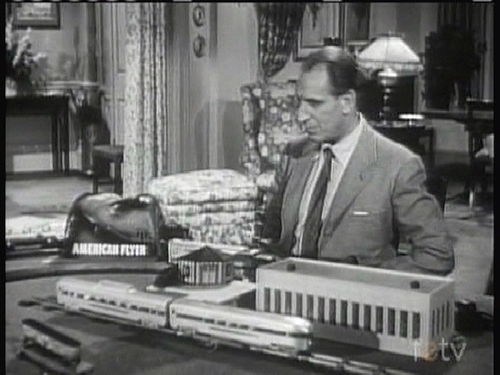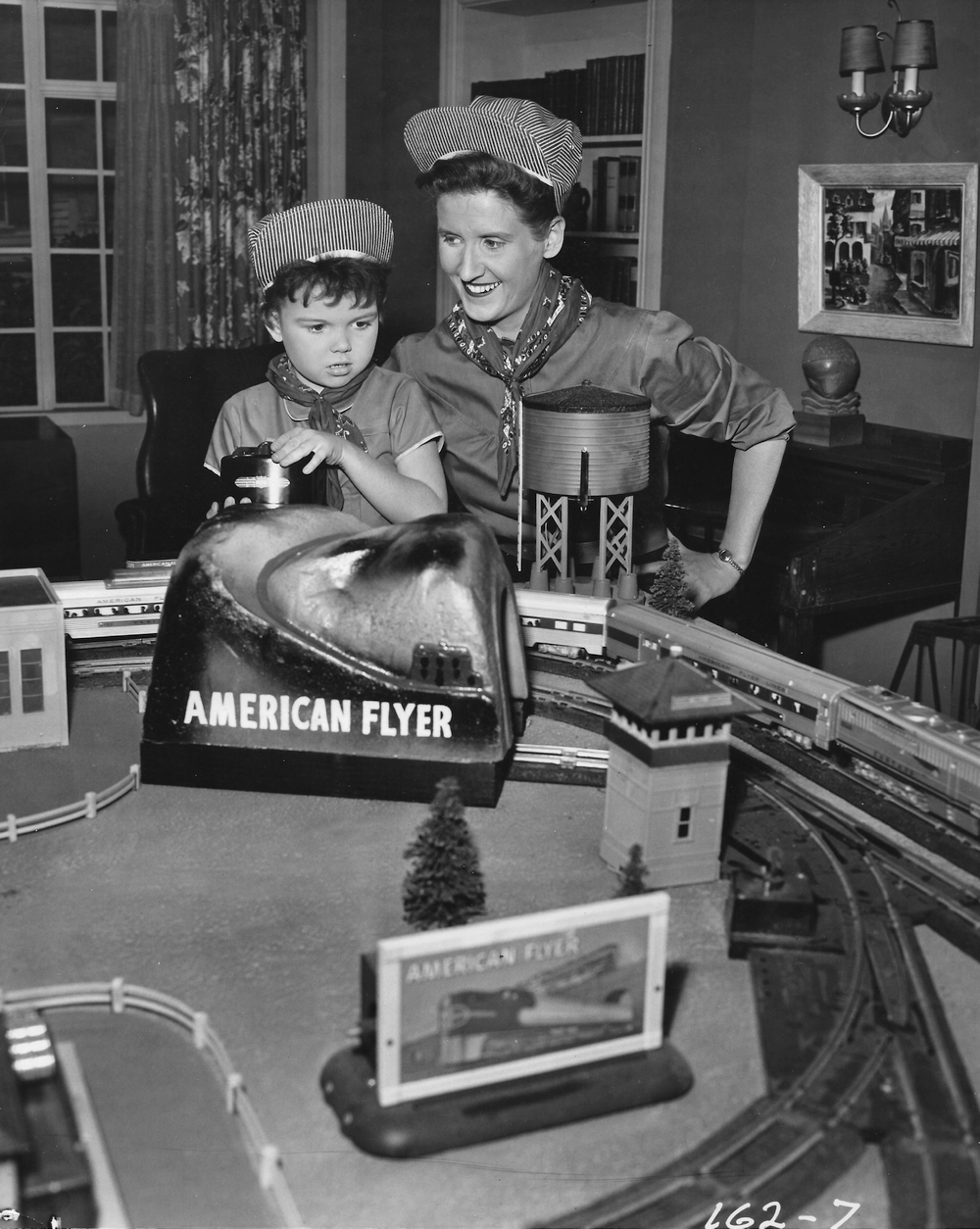Gilbert Goes Hollywood

| Click on the photos or text in the grid below to go to that section. When you are in the section, you can click on the title to return to the top of the page. |
Introduction
Today we are quite aware of product placements in our movies and television shows and sometimes get concerned about it. This isn't really anything new. In the 1950's, both Lionel and Gilbert made extensive efforts to get their products placed in TV shows and movies. There wasn't much controversy about it in those days and as kids we loved seeing our favorite toy trains on television and in movies. While Lionel had the "Lion's" share of such product placements, there are several examples of these Gilbert product placements available on the internet and this section will provide some links to video clips and other source information.
In line with the focus of this website on layouts, I have limited the coverage here to product placements involving layouts. There were many more examples of product placements that involved the full line of Gilbert products, many times as prizes on quiz shows.
Below are some links to just some of the product placements that are available for us to see today. Many of them are from the RFGCO YouTube channel, in particular one promotional film made by Gilbert in 1959. That promotional film was previously available on VHS tape under the title of "1959 Gilbert Film Spectacular." It is hosted by veteran actor and announcer Dick Fishell. If you view the whole film on YouTube, you can see that Gilbert really promoted the heck out of the Franklin sets. Franklin sets were given as prizes on numerous quiz shows and as presents to children suffering illnesses or hardship. The policy seemed to be that if one set was good, two were better, as there was more than one occasion when a package of two sets was given away to one individual.
Most of the links are to the relevant sections of the videos so you can conveniently see the layouts as featured in specific shows.
Calling Dr. Gillespie - 1942


Caution - Toy trains were harmed in the making of this film - Viewer discretion is advised.
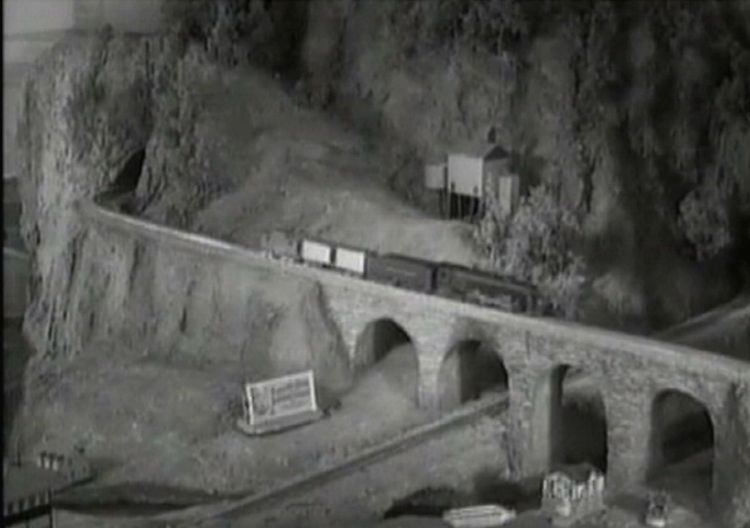 Now
why would a train manufacturer want their products featured in a
movie only to be destroyed by a madman? Perhaps the key is
that the American Flyer whistle is so realistic that it can trigger a violent
outburst by the unstable fiancé of Marcia Bradburn, played by Donna
Reed. As luck would have it, Roy Todwell has just purchased a golf club
for Marcia and has the means handy to destroy the trains.
We are never told exactly why the sound of train whistles triggers
his violent episodes. In the end, he is incarcerated
after killing 3 people and a cute Cocker Spaniel. (not shown
in this clip) Now
why would a train manufacturer want their products featured in a
movie only to be destroyed by a madman? Perhaps the key is
that the American Flyer whistle is so realistic that it can trigger a violent
outburst by the unstable fiancé of Marcia Bradburn, played by Donna
Reed. As luck would have it, Roy Todwell has just purchased a golf club
for Marcia and has the means handy to destroy the trains.
We are never told exactly why the sound of train whistles triggers
his violent episodes. In the end, he is incarcerated
after killing 3 people and a cute Cocker Spaniel. (not shown
in this clip) As to the trains, since this is 1942, they are three rail O gauge American Flyer. It is hard to see details, though, as the clip of the train action is pretty short. They appear to be 3/16 scale and Gilbert was well into the development of that line in 1942. In the photo at the left, we can see a Hudson pulling a box car and a caboose. A pretty short train, but maybe they knew what was waiting on the other side of that bridge. A billboard whistle, the star of the clip, is also visible. To see a larger display of the photo at the left, just click on the image or here. By the way, I was unable to find a "Stumyer's" department store so it is probably a fictional store. This is a huge layout and I doubt it was constructed just for this 40 second scene. If anyone can hazard a guess as to where this layout might have existed, please let me know at flyerdisplays@att.net. Any person who might be able to remember it would have to be in their late 80's at least. While the violence against the trains is severe, I would bet it was repairable. Thanks to Jerry Azzaro and Anna Kauffman for bringing this film clip to my attention. |
Christmas Eve - October 31, 1947


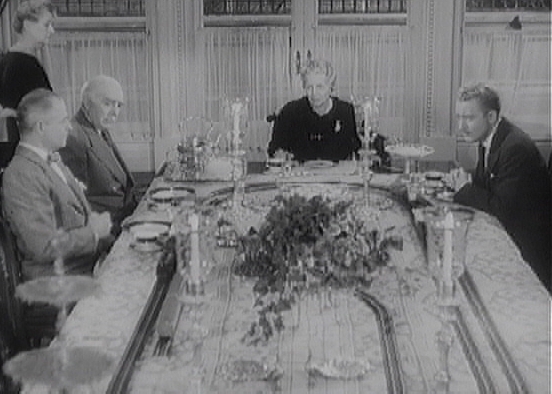 A
follower of this website tipped me off to this Christmas
movie being perhaps the earliest appearance of S gauge
American Flyer trains in a Hollywood production.
The movie was released on October 31, 1947 and features some
very early post war American
Flyer S gauge trains. In fact, some of the rolling stock
appears to be pre war American Flyer items with added S
gauge trucks. In particular, a passenger train
rounding a curve appears to be composed of 3/16 scale pre
war cars. A
follower of this website tipped me off to this Christmas
movie being perhaps the earliest appearance of S gauge
American Flyer trains in a Hollywood production.
The movie was released on October 31, 1947 and features some
very early post war American
Flyer S gauge trains. In fact, some of the rolling stock
appears to be pre war American Flyer items with added S
gauge trucks. In particular, a passenger train
rounding a curve appears to be composed of 3/16 scale pre
war cars. Another interesting feature is the track. It is very obviously not stock American Flyer track. Just who manufactured it is unclear. It appears to be similar to Tru-Scale track, more commonly associated with HO gauge trains of the 1950's. Though I have been informed that Tru-Scale did manufacture S gauge track, I have not been able to find any advertising for it in model railroad publications of the mid to late 40's. This, of course, begs the question as to why stock American Flyer track wasn't used. Is it possible that these sequences were filmed in 1946 and the use of other track was the result of a shortage of the newly manufactured Gilbert S gauge track? Or did the director want the neater appearance of roadbed track for the formal table. In the clip you can also see an early Virginian hopper carrying sugar cubes and a Gondola labeled "C&E", most likely carrying cream. I could find no evidence that Gilbert ever made a gondola decorated in this way. I wondered what C&E might stand for and then someone pointed out the obvious to me. "Christmas Eve" There is one small plot inconsistency that is obvious to those of us familiar with the history of American Flyer trains. In the story, these trains were supposed to have been played with by Aunt Mathilda's now grown sons when they were boys. Considering the ages of George Raft (46), George Brent (43) and Randolph Scott (49) at the time this movie was made, the trains would have been played with between 1910 and 1920 at the latest, a time when trains like these examples of 1940's state of the art technology were unknown. Take a good look at this clip and see if you can discern anything else or shed light on the track issue. Be sure to let me know by contacting me at flyerdisplays@att.net |
 Closeup of Track |
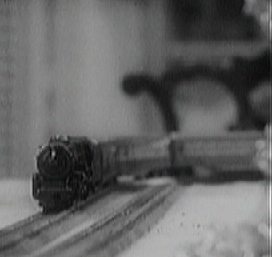 Passenger Cars |
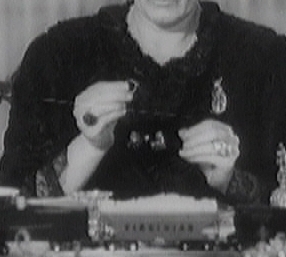 Virginian Hopper |
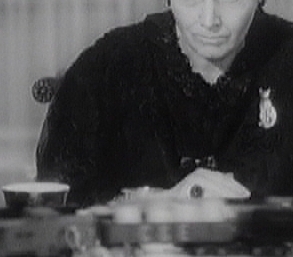 "C&E" Gondola |
Grounds for Marriage - January 19, 1951


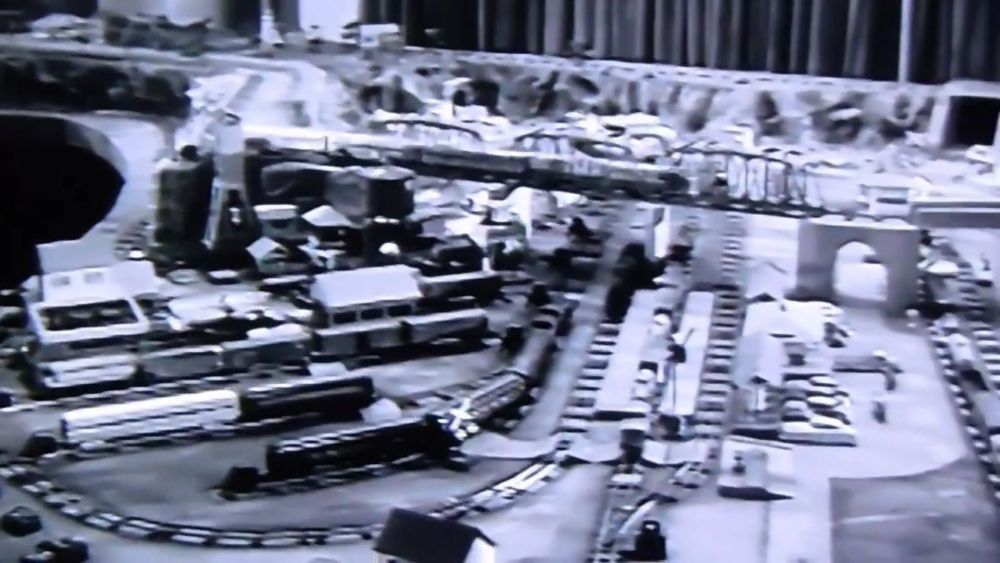 This
film, which was described by at least one critic as an escapist
attempt to provide a diversion from the ongoing Korean War, tells the story of a woman trying to woo back her ex-husband.
The scene that includes the American Flyer trains features the main
character's brother, a toy manufacturer, patronizingly explaining trains to a
female salesperson.
This
film, which was described by at least one critic as an escapist
attempt to provide a diversion from the ongoing Korean War, tells the story of a woman trying to woo back her ex-husband.
The scene that includes the American Flyer trains features the main
character's brother, a toy manufacturer, patronizingly explaining trains to a
female salesperson.
The layout featured is immense, which makes one wonder if it was built for some other purpose than as a movie prop. Also, the absence of rubber roadbed might indicate that this layout was built before 1950, when rubber roadbed was introduced The layout is obviously Flyer based on the presence of the two rail track and familiar rolling stock and accessories, but there is a twist. The featured train is a streamline passenger train pulled, not by Alco PA's, which were new that year, but by EMD F-3's or possibly F-7's, something Gilbert never made. Three portholes are visible in the B unit, but only two can be seen in the A unit making an F7 most likely.
If you take a close look at the streamline passenger cars, you notice something different about them also. First of all, the end of the observation appears to be less elongated than a Flyer observation. In addition, the baggage door windows on the combine are at the same level as the passenger windows, unlike an American Flyer combine where the windows on the baggage door are at a higher level than the passenger windows.
For more information on possible explanations of the unusual streamliner, click on the link below.
Roadblock - September 17, 1951


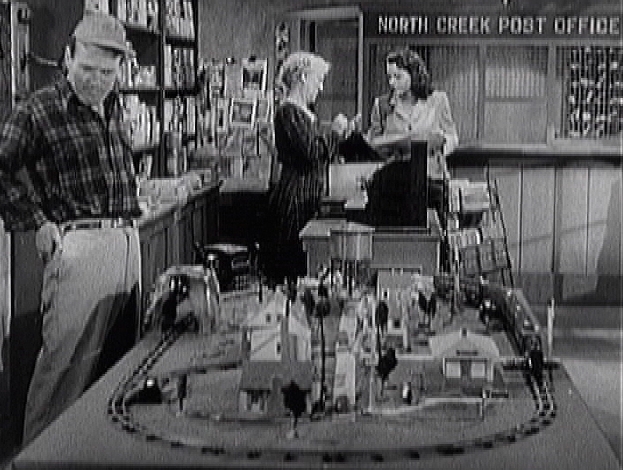 American Flyer trains make a brief
appearance in this 1951 Film Noir classic. The story line
involves an insurance company detective who uses inside information
to plan a train robbery to give him the money he needs to impress
his luxury loving girlfriend. The American Flyer scene comes
in the general store of the small town where he is hiding out after
the robbery. In it he appears to be ruminating about the
robbery. Interesting details of the scene are
a Lionel ZW transformer powering the simple loop which appears to
have a reverse loop connecting one side of the layout with the other
side. The ZW is probably an indication that this layout wasn't
designed by Gilbert, but rather by the studio. The train is an
Atlantic pulling two baggage cars and two coaches. The baggage
cars appear in one shot which shows the side of the cars and reveals
that they are operating mail cars. American Flyer trains make a brief
appearance in this 1951 Film Noir classic. The story line
involves an insurance company detective who uses inside information
to plan a train robbery to give him the money he needs to impress
his luxury loving girlfriend. The American Flyer scene comes
in the general store of the small town where he is hiding out after
the robbery. In it he appears to be ruminating about the
robbery. Interesting details of the scene are
a Lionel ZW transformer powering the simple loop which appears to
have a reverse loop connecting one side of the layout with the other
side. The ZW is probably an indication that this layout wasn't
designed by Gilbert, but rather by the studio. The train is an
Atlantic pulling two baggage cars and two coaches. The baggage
cars appear in one shot which shows the side of the cars and reveals
that they are operating mail cars. |
Oklahoma Annie - Staring Judy Canova - 1952


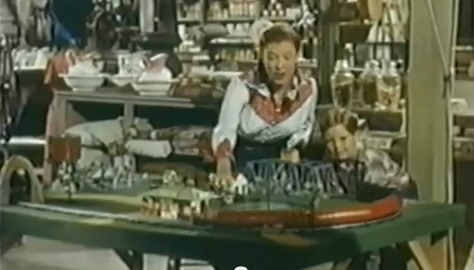 This video clip was the only one I found from a
color theatrical
release film, albeit a B grade western. From the clip, it appears to be the start
of the film, but that may not be the case. It features Judy
Canova playing a shopkeeper who gets involved in cleaning up
corruption in her town. She sings the song, "Blow the Whistle" while an American Flyer
K-5 Pacific pulls a train of red passenger cars, which appear to be
a New Haven style baggage car, a New Haven style coach, and a
heavyweight observation. The layout was very simple,
consisting of an oval of track with a station, house, trestle
bridge, water tank, tunnel, crossing gate, and magnetic crane.
All of this is consistent with products cataloged that year.
The general consensus is that this clip is best enjoyed with the
sound muted. This video clip was the only one I found from a
color theatrical
release film, albeit a B grade western. From the clip, it appears to be the start
of the film, but that may not be the case. It features Judy
Canova playing a shopkeeper who gets involved in cleaning up
corruption in her town. She sings the song, "Blow the Whistle" while an American Flyer
K-5 Pacific pulls a train of red passenger cars, which appear to be
a New Haven style baggage car, a New Haven style coach, and a
heavyweight observation. The layout was very simple,
consisting of an oval of track with a station, house, trestle
bridge, water tank, tunnel, crossing gate, and magnetic crane.
All of this is consistent with products cataloged that year.
The general consensus is that this clip is best enjoyed with the
sound muted. |
Herb Sheldon Show - 1953
Herb Sheldon was a Television host for many years on several different New York City television stations. During that time, he hosted a variety of shows, many of which were aimed at Children and teenagers. Among his children's shows were Saturdays With Herb Sheldon, Sheldon At Six, Kids Today and One Is For Sheldon. After looking at a Youtube video of one of his teen dance party shows, it appears that he frequently changed hats for different ads. For more information, you can look up his name on Wikipedia.
This shot with Maury Romer was marked on the back as being from 1953 and the American Flyer equipment pictured is consistent with that date. In particular, the layout appears to be a 1953 version of the number 300 display featured on another page of this website.
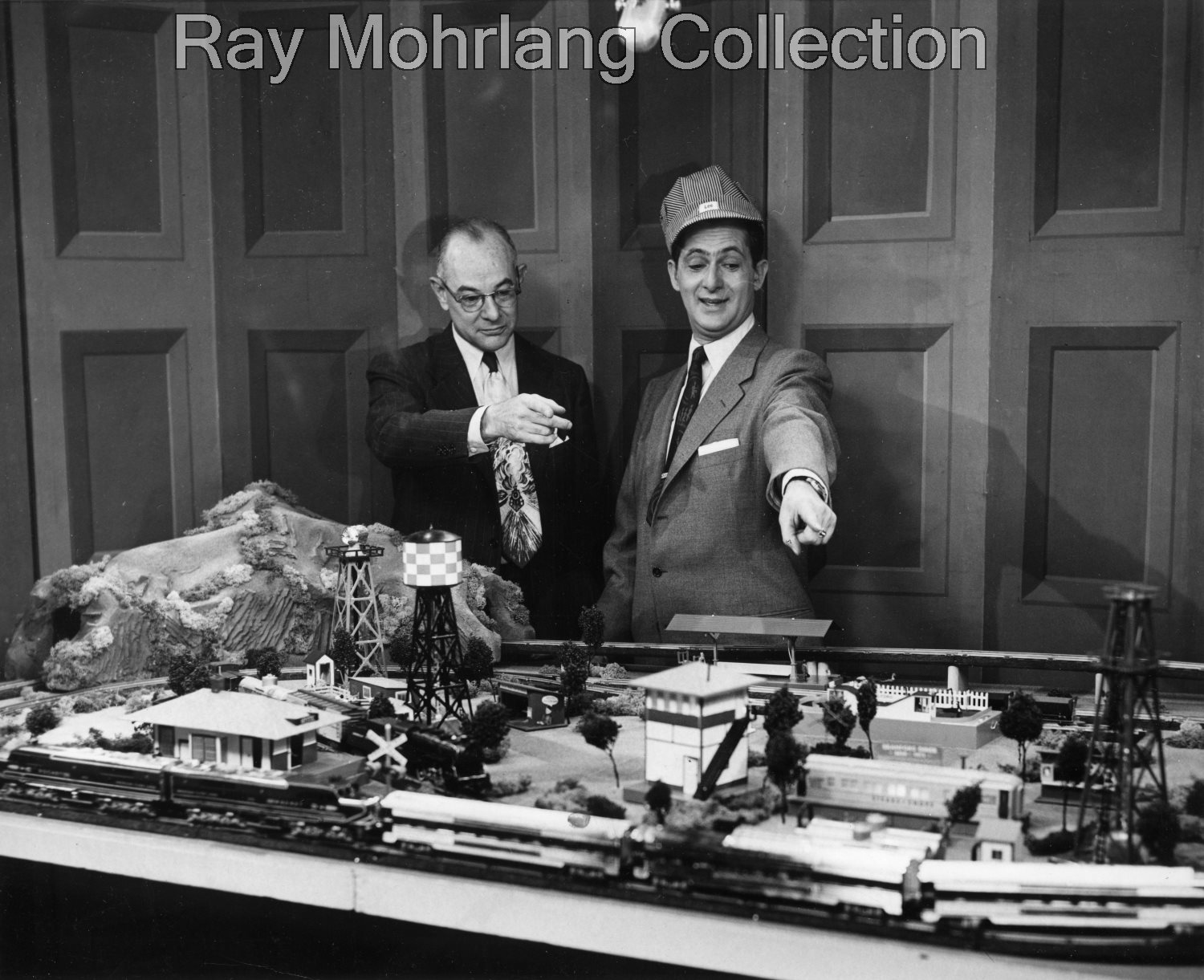
Howdy Doody Show - December 24,
1953




.Movie_Snapshot.jpg) This show, televised the day before Christmas 1953, showed a short film about Gilbert Erector and American Flyer trains as an alternate to their normal "old time movie." It was dubbed a "Howdy Doody Newsreel." In the first link above, you can watch the entire "newsreel" covering both Erector and American Flyer. The second link starts at the American Flyer portion. The layout is clearly the 2nd floor layout at the New York Hall of Science and it shows the major changes in the track plan, features, and accessories that were made in 1953. There also appear to be a few missteps in the narration by Buffalo Bob who comments on two tons of "plastic" (plaster?) being needed to build the layout. There is also a reference to a "Yardbird Switch" rather than "Switcher." |
WJAR Providence, RI Television show - 1954
Not much is known about this photo other than what is written on the back. The picture is of Maury Romer with M. Claire Terrien. I don't know who this person is and a Google search was unproductive. The photo was apparently taken on a set at WJAR, a Providence, Rhode Island television station. A date of "52" is written on the back, but this seems too early for the equipment shown, in particular the Union Station which was introduced in 1954. In addition, the Rocket set appears to be short one vista dome for either 1953 or 1954. If anyone can provide more information, please contact me at the contact link at the bottom of this page or on the home page.
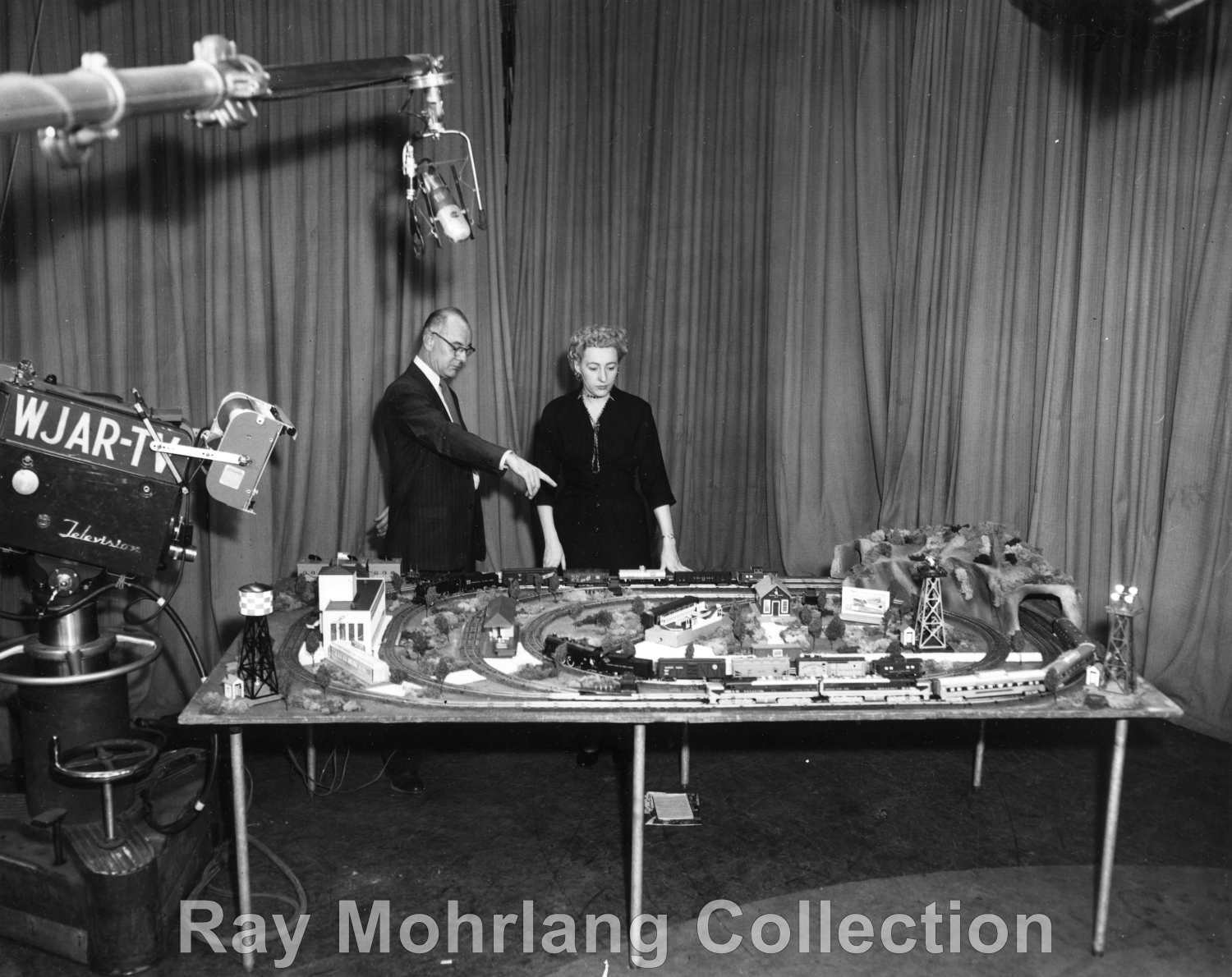
WJAR Studio Photo

WJAR Layout Closeup
George Burns & Gracie Allen Show - Anniversary Party - November
28, 1955


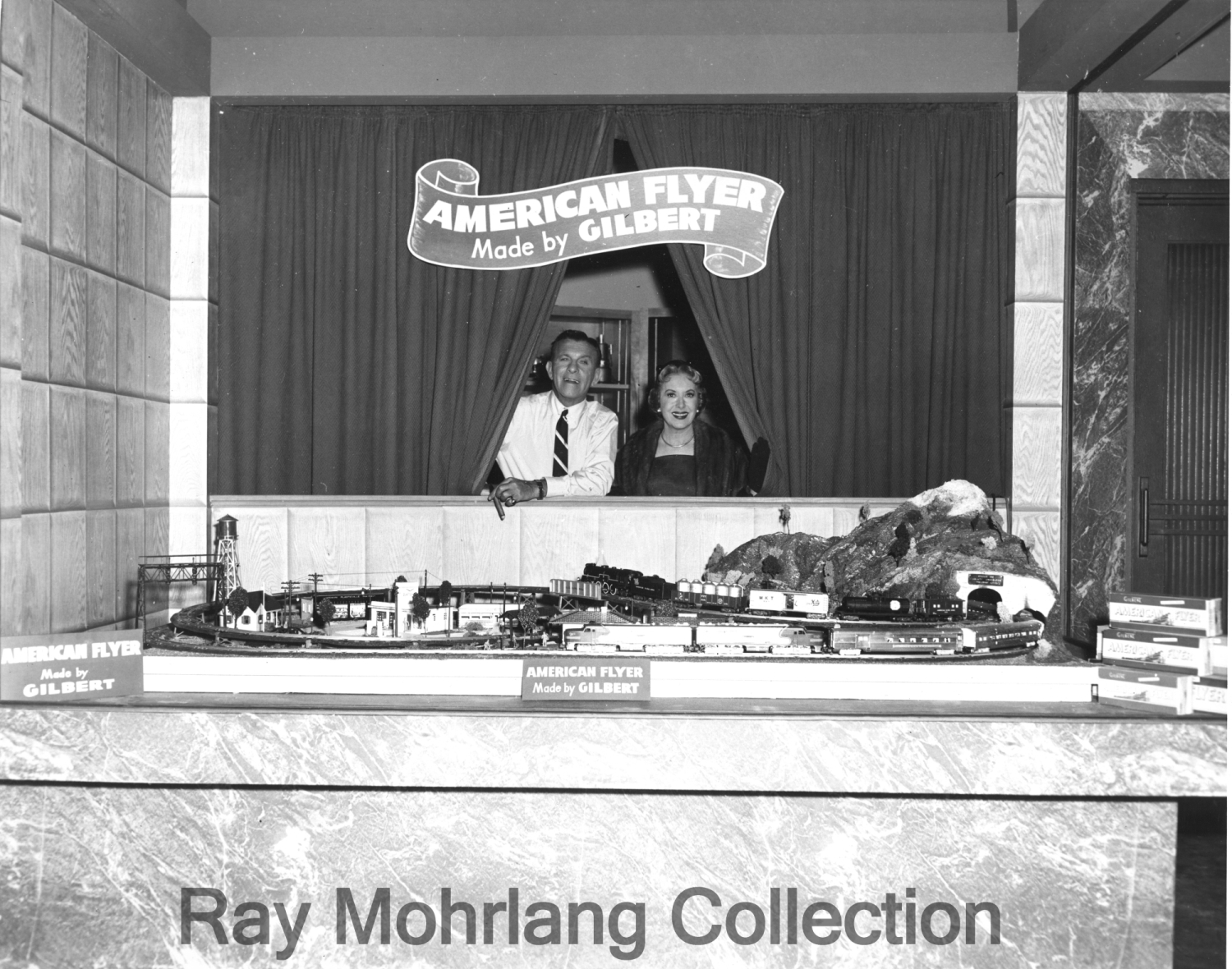
When I first saw this photo, I was unsure of what it
represented, but thanks to Lonny Beno, who put this in
context for me, I now know the full story. This is a photo
of the American Flyer layout that is featured in an episode
of the Burns and Allen show titled "Anniversary Party,"
Season 6, Episode 9, which aired on November 28, 1955. The
shot doesn't appear in the show, but it provides a better
view of the layout than what does appear in the show. I
would imagine that this photo was taken by the A.C. Gilbert
Co. for use in advertising and to document the appearance of
its trains in this show. The train action begins immediately
as the curtain opens and the scene in front of the toy store
lasts about 3 and 1/2 minutes. Aside from Gracie's
conversation with a lady about the possibility of the train
as a gift for the lady's son, the trains and the display
play no real part in the show and are simply props. There
are only fleeting glimpses of the layout for the first few
seconds, but signs identifying the brand of the trains are
visible long enough to be read. The layout doesn't appear to
match any of the factory displays that I am aware of, but
there are probably other displays, not documented on this
site.
It has been suggested that this shop front is in actuality
the 5th Avenue side of the New York Hall of Science. It is
definitely reminiscent of that area of the building as it
was originally constructed, but by the date of this show,
which is definitely documented as November 28, 1955, the 5th
Avenue entrance had been eliminated. In 1954, the entire 5th
Avenue window display area had been redone to accommodate
the large display layout (The Super Layout) described
elsewhere on this website. The accommodations involved
increasing the size of the window and eliminating the entry
door on that side of the building. Also the area housing the layout in this photo
does not appear to be much wider than about 10 feet.
Previous layouts that were displayed in this window appeared
to be much wider than that, most likely around 16 feet.
It is quite possible, though, that this photo was taken near
the Hall of Science. The Collector, a publication of the
former American Flyer Collector's Club, published some
recollections by Maury Romer in the Fall 1989 issue (Volume
12, No. 3). Among these was a small reprint of the photo
above with the following notation. "A similar American Flyer
Display was at 1107 Broadway, NYC. The picture shows George
Burns and Gracie Allen looking over the Flyers."
My educated guess would be that the layout in the photo was on the other side of Broadway at the corner of W. 25th Street. I don't believe that that the layout was housed in the display window on the Broadway side of the Hall of Science, as the entry door there was on the left side of the window, not the right. Assuming that the address is correct, as an odd number it would be on the opposite side of the street. The Hall of Science was on the even side of Broadway. The 1107 Broadway address does not appear to be used today as the chicken restaurant located at that corner location uses the address of "1123 Broadway," the address of the main building of which that storefront is a part. I would also think that if the layout had been in the Hall of Science building, that is how Maury Romer would have referred to it, rather than by an address.
You Asked For It - Factory
Tour - 1956




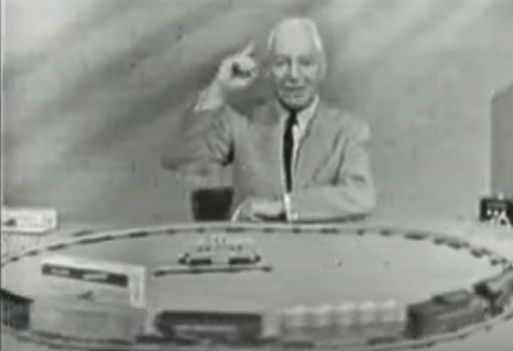 At
the suggestion of Lonny Beno, I added a link to this Youtube
clip in this section of the website. There are
actually two versions of this production. Art
Baker hosted the show between 1950 and January 1958.
Jack Smith took over then and hosted it for the 20 months
remaining until the show was cancelled in 1959. He
also hosted a revival in 1972 and did voice over of older
clips in a later revival in the 1980's. The Jack
Smith
clip is most likely from the 20 months in 1958 and 1959, as
Gilbert was no longer in business at the time of the later
revivals and the show wouldn't have been relevant. At
the suggestion of Lonny Beno, I added a link to this Youtube
clip in this section of the website. There are
actually two versions of this production. Art
Baker hosted the show between 1950 and January 1958.
Jack Smith took over then and hosted it for the 20 months
remaining until the show was cancelled in 1959. He
also hosted a revival in 1972 and did voice over of older
clips in a later revival in the 1980's. The Jack
Smith
clip is most likely from the 20 months in 1958 and 1959, as
Gilbert was no longer in business at the time of the later
revivals and the show wouldn't have been relevant.While it isn't the same sort of thing we find in the other film clips, where the trains are a subtle backdrop to the other action in the film, it is still a Hollywood production with probably the best product placement of all - as the main attraction. Here the sole purpose of the clip is to tell the back story of how these trains are made. It gives us a behind the scenes view where many of our familiar friends, such as Maury Romer, Ray Smith, and Russell Smith are either mentioned or appear. Gabe Monaco, for whom Gabe the Lamplighter is named also appears at 1:57 in the first clip going over the prototype for the Oil Drum Loader with Maury Romer, but is not mentioned by name. Lonny and I are both pretty sure the earlier clip is from 1956 based on the products shown, but I haven't been able to determine the exact date of the show. |
The Big Studio Layout
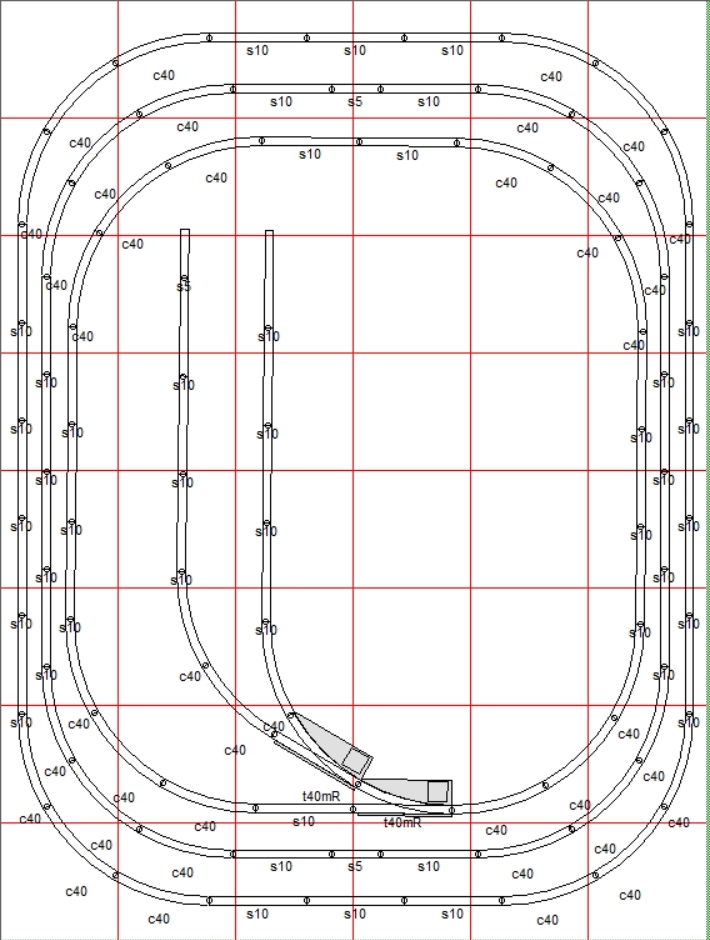 It has been suggested by some that Gilbert created a large layout
that was taken from one soundstage to another for American Flyer
product placements in various shows. In the 1st through 3rd editions of
Greenberg's Guide to American Flyer S Gauge there is a well researched article
at the front of the book written by Linda Greenberg titled " Overview." 1
The article has been revised throughout the various editions, but
the versions that appear in the 2nd and 3rd editions are quite
similar. They were the first versions to discuss the traveling
studio layout. The version that appears in
Volume II of the 4th edition under the title of "History of American Flyer
Trains," covers the topic, but is a significantly revised version of
the earlier articles.
2
It has been suggested by some that Gilbert created a large layout
that was taken from one soundstage to another for American Flyer
product placements in various shows. In the 1st through 3rd editions of
Greenberg's Guide to American Flyer S Gauge there is a well researched article
at the front of the book written by Linda Greenberg titled " Overview." 1
The article has been revised throughout the various editions, but
the versions that appear in the 2nd and 3rd editions are quite
similar. They were the first versions to discuss the traveling
studio layout. The version that appears in
Volume II of the 4th edition under the title of "History of American Flyer
Trains," covers the topic, but is a significantly revised version of
the earlier articles.
2
In the versions of the article in the 2nd and 3rd editions, a section subtitled "Department Store Layouts - As told by Frank Edgcombe" gives us some interesting information about those layouts. Frank Edgcombe worked at the New York Hall of Science and the showroom at 200 5th Avenue that replaced the Hall of Science in 1959. According to Frank, the layouts were fabricated in New Haven in 5 x 10 foot modules. Together, the two modules would form a 10 x 10 foot layout. In Linda Greenberg's article the following was noted: "One large layout was used exclusively for television shows. It could be set up and taken down in less than a half hour! Requests for American Flyer layouts to appear on TV shows were frequent; they came from the Dave Garroway Show (now the Today Show), The Price Is Right, Top Dollar, and American Bandstand with Dick Clark. No wonder these layouts were in demand: three trains could run simultaneously, and the layout featured the latest operating accessories. The show's host would operate a dummy control panel while Edgcombe, by means of an umbilical cord hooked up to an identical control panel hidden behind the scenes, would press the correct button to make the accessory operate, such as the rocket launcher. American Flyer was getting five to ten minutes of nationwide coverage at no charge for each appearance. "3
The next five layouts to be discussed may be examples of how this big layout was used, apparently in different sizes for different shows. Judging from the appearance of the layouts, I believe there are two different size layouts represented in the five clips presented here. Based on my review of the photos and video footage available, I believe the layout size in all but two of the shows discussed below was 6' x 8' and probably consisted of two 4' x 6' panels. The two layouts that may have been bigger were the layout used in Date with the Angels, which appears to be significantly wider than the others, and the layout that was used in the introduction to an episode of Dick Powell's Zane Grey Theater.
This difference in size may be related to where the shows were filmed. Leave it to Beaver, The Bob Cummings Show, and The Millionaire, all of which appear to feature a smaller 6' x 8' layout, were all filmed in California. Date With The Angels, for its short run, was filmed at 3 locations in North Carolina. Most of the episodes of Dick Powell's Zane Grey Theater were filmed in California and the Southwest, but since the layout segment was only an introduction it could have been filmed elsewhere and simply inserted in the final production.
It might have been possible that these layouts were put together quickly as alluded to by Frank Edgcombe, but in some cases, such as the Leave It To Beaver layout, it looks like the Gilbert crew did a more careful job.
Date With The Angels - Santa's Helper - December 13, 1957


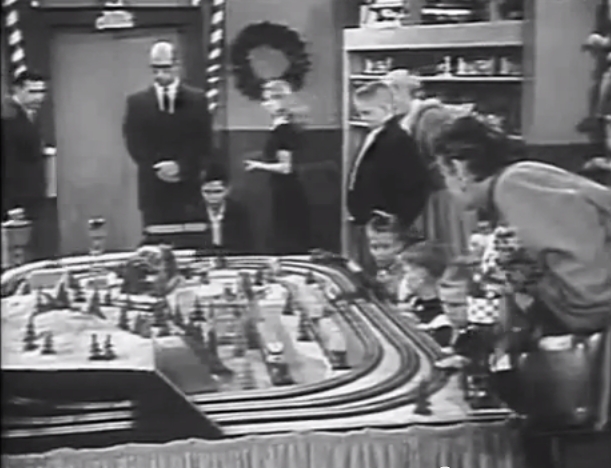
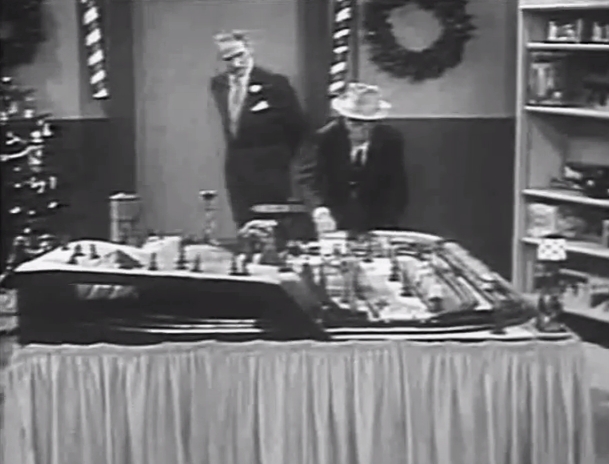
Date With the Angels was a relatively short lived television series starring Betty White and Bill Williams as a newly married couple. It ran from May of 1957 until January of 1958 and produced only 33 episodes. One of these, titled "Santa's Helper," featured a layout that looks very much like it could have been the "Big Studio Layout" spoken of by Frank Edgcombe. The layout appears in fleeting glimpses throughout the entire show, so the entire video is included in the link above. While the three subsequent layouts discussed appear to be examples of a 6' x 8' "Big Studio" layout, this layout looks to my eye to be almost square, most likely an 8' x 8' layout formed by two 4' x 8' sections. In the first photo above, note that there is a significant length of strait tracks approaching the tunnel at the lower left. On the 6' x 8' layouts, the curved sections extend much closer to the tunnel portal, as shown in the photo of The Millionaire layout below.
Leave It To Beaver - My Brother's Girl - April 16, 1958


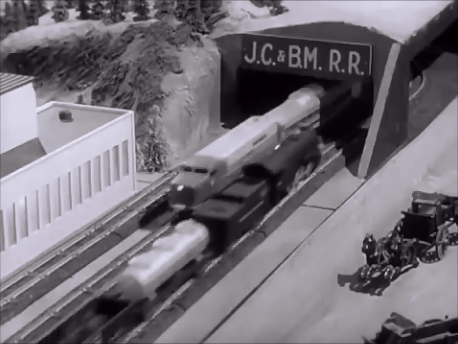 |
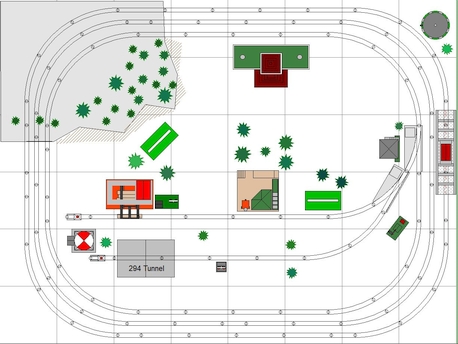 Track Plan by Daryl Olszeski |
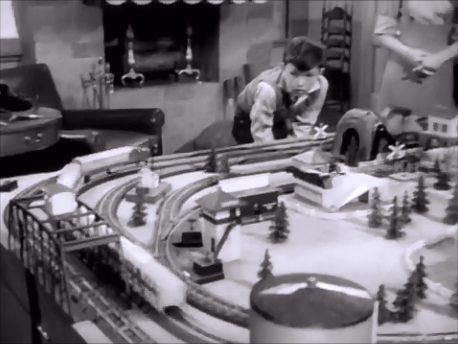 |
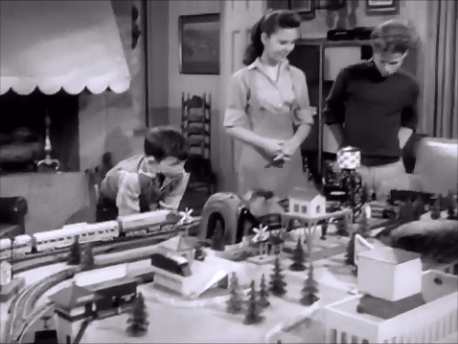 |
More than any of the other possible "Big Studio" layouts, this one has captured the interest of many American Flyer fans. The reason is most likely because the layout seems to be the best detailed of the layouts. Although the layout only appears on screen about a minute, the photography is close up and shows many of the details of the layout. In short, the productions values are far better than those demonstrated on clips of the other layouts, even though this show is essentially contemporaneous with the others. Also, it is the only one of the four layouts where the layout itself is relevant to the plot of the story.
From the video, we know that this layout, like the other possible "Big Studio" layouts, also consists primarily of three loops of track. The layout is nicely sceniced and well presented. It presents one enigma though. Over the tunnel portal the letters "J.C. & B.M. R.R. appear. I have puzzled over this for some time, but I think I now have the answer, thanks to Mike Schmidt and Mike Nickel, who both suggested that those are the initials of Joe Connelly and Bob Mosher, the creators and producers of the series and that the railroad was named for them. I think that pretty much answers the question.
The Millionaire - The Dan Howell
Story - November 5, 1958


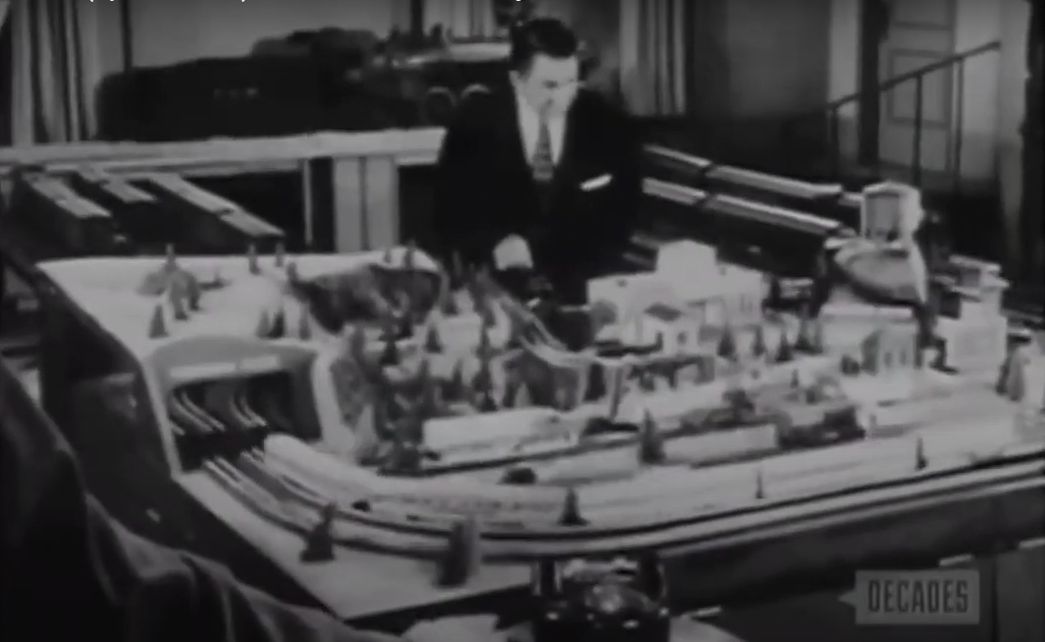 In
each episode of this show, Michael Anthony, the Executive
Secretary to "fabulously wealthy" John Beresford Tipton, is tasked
with the mission of presenting a check for one million dollars to
some unsuspecting beneficiary of Mr. Tipton's largese. In this
particular episode, it is noted that Mr. Tipton has the time and
resources to indulge his hobbies, one of which appears to be model
trains. Mr. Anthony gets his marching orders on the other side
of Mr. Tipton's large American Flyer Layout.
In
each episode of this show, Michael Anthony, the Executive
Secretary to "fabulously wealthy" John Beresford Tipton, is tasked
with the mission of presenting a check for one million dollars to
some unsuspecting beneficiary of Mr. Tipton's largese. In this
particular episode, it is noted that Mr. Tipton has the time and
resources to indulge his hobbies, one of which appears to be model
trains. Mr. Anthony gets his marching orders on the other side
of Mr. Tipton's large American Flyer Layout.
This layout appears to be the same "Big Studio Layout" described above. While the quality of the video is not the best, it gives us a view from the opposite side of the layout as compared to the shots in the Leave it to Beaver video above, which aired just a few months before this show. Though the details of the layout are hard to make out, we can definitely see many of the same accessories in the same locations on both layouts. Though the view in this video is on the other side of the layout, the shot of the train going into the tunnel, with whistle blowing, is reminiscent of a similar scene in the Leave it to Beaver video. In this episode, the train actually participates in the story by providing the transportation that takes the check, via gondola, from Mr. Tipton to Mr. Anthony. The American Flyer action takes place in the first few minutes, but just keep watching if you want to see the rest of the episode.
Dick Powell's Zane Grey Theater - A Thread of Respect - February
12, 1959


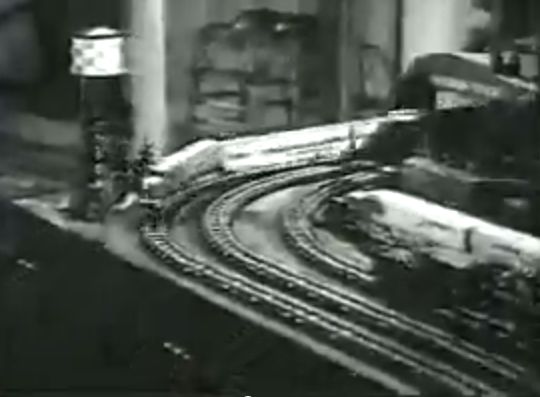
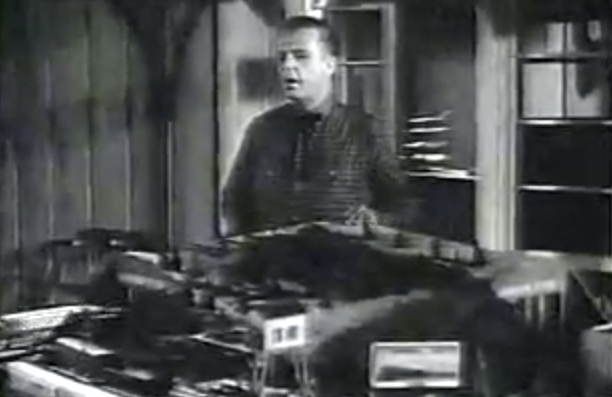
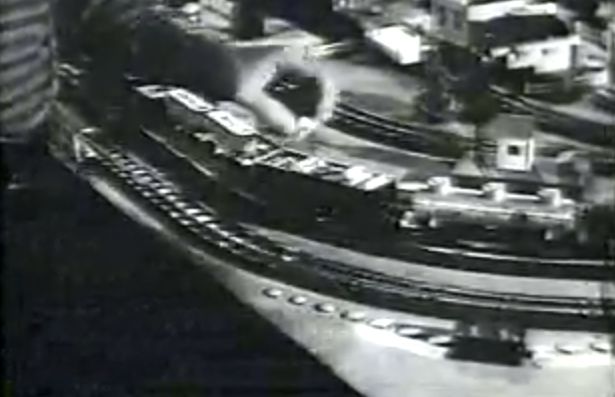
Dick Powell's Zane Grey Theater ran from 1956 until 1961 and represented some of the best quality television programming of this era. In this episode, titled "A Thread of Respect," Danny Thomas stars as an Italian tailor who arrives by train in Yucca City, Arizona and ends up challenging the town tough played by James Coburn. The American Flyer layout is featured in Dick Powell's somewhat corny introduction of the story. The layout appears to be consistent with the dimensions of a larger size square "Big Studio Layout" similar to the one used in Date with the Angels above. The evidence for this is in the additional straight sections of track leading into the tunnel in the first photo above. It is interesting to note that one of the cutaway shots features old time locomotives on an HO display. Also, Dick picks up what are clearly Mantua General cars from the layout. They are not even the Gilbert versions of those cars that Mantua manufactured for Gilbert's HO line at that time. The clip is from the 1959 Gilbert Film Spectacular video.
The Bob Cummings Show




|
The 1959 Gilbert Film Spectacular contains two sets of clips showing what I believe to be the last example of the "Big Studio Layout." I believe the clips are from the show, "Bob The Babysitter," but they could be from two different shows. Since the layout was in the living room of the house where the main characters lived, I think it is likely to be from the same episode, since I doubt that the producers would want to commit to a living room train setup for more than one episode. If they did, it would have been a real coup for Gilbert. The layout has three loops of track, with the signature mountain
in the same corner as on other possible examples of the "Big Studio Layout." In the first photo below, you can see that
the layout is composed of two sections. Each section
is supported by two side walls, with the two inner walls against
each other. This is quite clearly what former Hall of
Science employee Frank Edgcombe
indicated in the article referenced in footnote 3 below.
Frank also said that the trains were often controlled by an off
screen operator connected by an "umbilical cord." He was often
that off screen operator. The action
sequences involving this layout support this theory. See if you can find the
spots in the clip where Rosemary De Camp and other characters stop
the train by picking up an unconnected transformer (no wires are
connected to any posts) and using it like a walk around throttle.
|
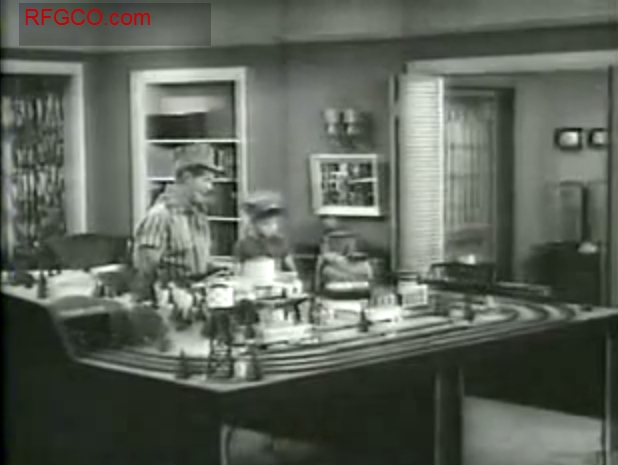
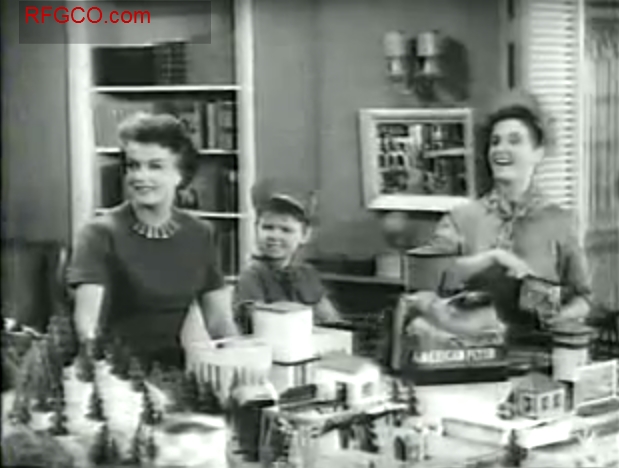
Perry Mason
- May 16, 1959


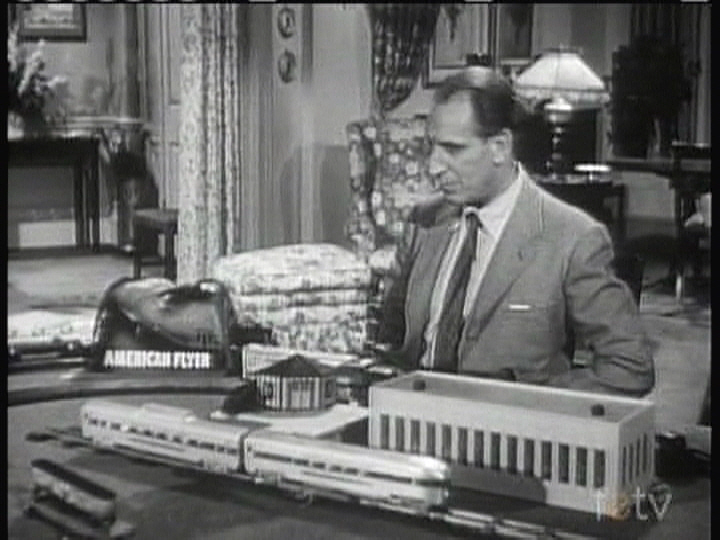 This
episode
from Season 2 (Episode 27, "The Case of The Deadly Toy") aired on
May 16, 1959.
It contains two short clips showing an American Flyer Layout
in a living room. The full episode was previously available at tv.com, but all Perry
Mason episodes have now been removed. The episode has also
appeared in syndication on FETV (Family Entertainment Television)
which is available on DirecTV. There are two places in the
episode, both after the first set of commercials, where American
Flyer trains are shown. The first clip appears at 4 minutes
and 30 seconds
and consists of a background view of a child moving items around on
a layout that has been set up on saw horses in the living room and
perhaps cleaning track.
It lasts about 30 seconds, but shows little of the layout. The
other clip, which occurs at 8 minutes
and 30 seconds into the show is shorter but provides the
better view of the layout.
More information on the episode can be found on a
Perry Mason fan website
where the American Flyer product placement is mentioned.
Just to set your mind at ease, the American Flyer train is not the
deadly toy. This
episode
from Season 2 (Episode 27, "The Case of The Deadly Toy") aired on
May 16, 1959.
It contains two short clips showing an American Flyer Layout
in a living room. The full episode was previously available at tv.com, but all Perry
Mason episodes have now been removed. The episode has also
appeared in syndication on FETV (Family Entertainment Television)
which is available on DirecTV. There are two places in the
episode, both after the first set of commercials, where American
Flyer trains are shown. The first clip appears at 4 minutes
and 30 seconds
and consists of a background view of a child moving items around on
a layout that has been set up on saw horses in the living room and
perhaps cleaning track.
It lasts about 30 seconds, but shows little of the layout. The
other clip, which occurs at 8 minutes
and 30 seconds into the show is shorter but provides the
better view of the layout.
More information on the episode can be found on a
Perry Mason fan website
where the American Flyer product placement is mentioned.
Just to set your mind at ease, the American Flyer train is not the
deadly toy. |
The Price Is Right


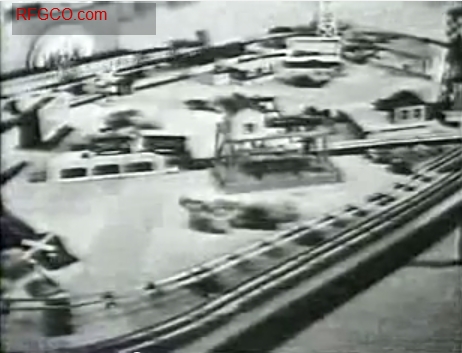 In this quiz show, the contestants try to guess the value of the
item in question, which for this episode included an American Flyer
Train layout. In this case, they drastically underestimate the
value of the layout. From viewing the video, it appears
that the layout in question is a standard 28142 factory display layout. In this quiz show, the contestants try to guess the value of the
item in question, which for this episode included an American Flyer
Train layout. In this case, they drastically underestimate the
value of the layout. From viewing the video, it appears
that the layout in question is a standard 28142 factory display layout. |
It Could Be You
|
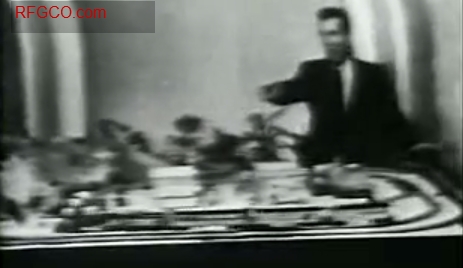 It Could Be You, like Queen for a Day, awarded prizes based on
hardships suffered, but here the emphasis was said to be more on
embarrassments, rather than genuine hardships. In the case of
this American Flyer layout though, it was awarded to a child whose
trains and all his possessions had been burned in a fire.
Perhaps these were the forerunners of todays reality TV shows. It Could Be You, like Queen for a Day, awarded prizes based on
hardships suffered, but here the emphasis was said to be more on
embarrassments, rather than genuine hardships. In the case of
this American Flyer layout though, it was awarded to a child whose
trains and all his possessions had been burned in a fire.
Perhaps these were the forerunners of todays reality TV shows. |
Arthur Murray Dance Party


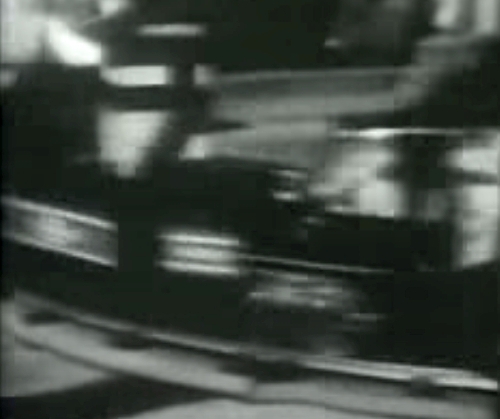 In this segment, a brief glimpse of an American Flyer train
enhances the Christmas mood for Jane Harvey's rendition of "Have
Yourself a Merry Little Christmas." There is not much more
train action than a blurry Frontiersman rounding a curve. In this segment, a brief glimpse of an American Flyer train
enhances the Christmas mood for Jane Harvey's rendition of "Have
Yourself a Merry Little Christmas." There is not much more
train action than a blurry Frontiersman rounding a curve. |
Engineer Bill - Cartoon Express on Los Angeles Television
KHJ-Channel 9 - 1956-1966
|
Bill Stulla, as Engineer Bill, was a legend in Southern California from 1954 until 1966. His show appears to have ended about the same time the Gilbert Company did. While the trains on the show layout were all American Flyer, he gave HO model kits to the children who were to be guests on his next show. They were to complete them before their appearance and bring them in to the show when they appeared. In addition to the Engineer Bill show, Bill Stulla also did publicity work for a TT gauge train manufacturer. The photo below may be an example of that.
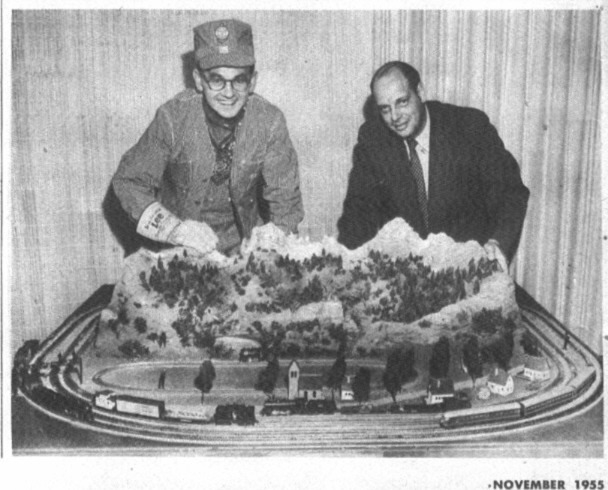
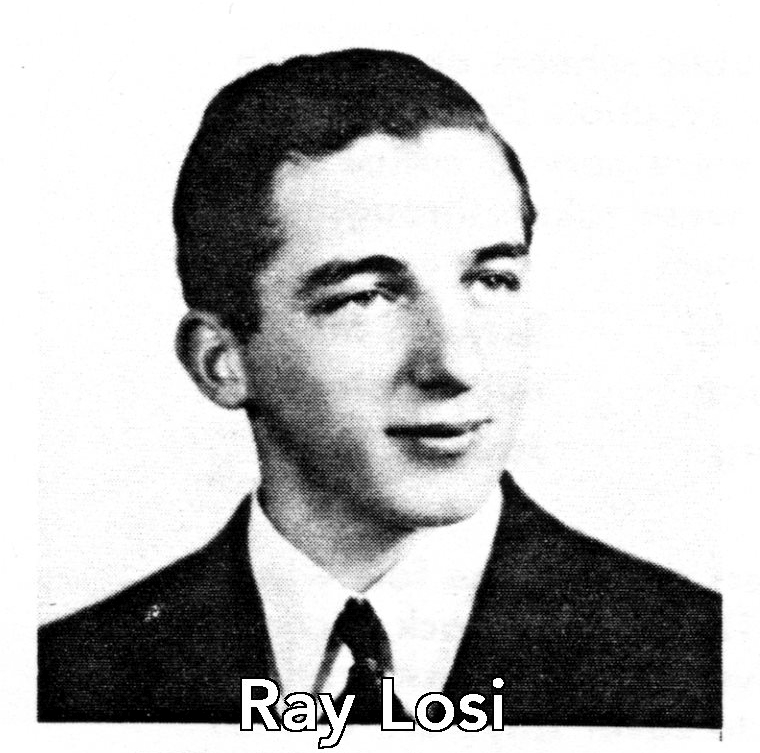 The
Engineer Bill TV show presented a great opportunity for a young
Gilbert Salesman in Los Angeles. In November before the show started, Lionel had been
contacted by Bill Stulla about providing a layout for the show.
They told him that it was their busy season and to call them back in
February, but they couldn't do anything at the time. After the
show had been running for two weeks, Bill received a call from Ray
Losi, an American Flyer representative in Southern California, who
said he liked the show and asked if there was anything he could do
for them. Bill asked him for a layout and within two weeks Losi provided one, which was seen on future episodes of the show.
The
Engineer Bill TV show presented a great opportunity for a young
Gilbert Salesman in Los Angeles. In November before the show started, Lionel had been
contacted by Bill Stulla about providing a layout for the show.
They told him that it was their busy season and to call them back in
February, but they couldn't do anything at the time. After the
show had been running for two weeks, Bill received a call from Ray
Losi, an American Flyer representative in Southern California, who
said he liked the show and asked if there was anything he could do
for them. Bill asked him for a layout and within two weeks Losi provided one, which was seen on future episodes of the show.
The show featured the Red Light/Green Light game to encourage children to drink their milk. They were supposed to drink on the green light and stop on the red light, as "Freight Train Wayne" would shout out the instructions from the sidelines, sometimes throwing in false cues, such as "red bird." Another feature of the show was the Get Well Board, where personalized get well messages were sent out to children who were ill.
While the links above show only bits and pieces of actual layout footage, they will certainly bring back memories to those who enjoyed these shows in the 50's and 60's.
There is an excellent article in Classic Toy Trains, April 1992 edition about Bill Stulla and his years as Engineer Bill. 4 Also, don't miss the video of Bill Stulla's reminiscences on the link above.
Bill Stulla died at the age of 97 on August 12, 2008
Notes
1 Greenberg's Guide to American Flyer S Gauge, 1st, 2nd, and 3rd Editions, Greenberg Publishing Company, Inc., Sykesville, MD, 1980 (1st Edition), 1984 (2nd Edition), and 1988 (3rd Edition)
2 Greenberg's Guide to American Flyer S Gauge, Volume II, Greenberg Books Division of Kalmbach Publishing Company, Inc., Waukesha, WI, 1991 (accompanies 4th Edition of Volume I)
3 Greenberg's Guide to American Flyer S Gauge, 2nd and 3rd Editions, Greenberg Publishing Company, Inc., Sykesville, MD, 1984 (2nd Edition) and 1988 (3rd Edition) at page 16 in both editions.
4 Bill Stulla Recalls his Years as TV's
Engineer Bill, Classic Toy Trains, April 1992, Page 110
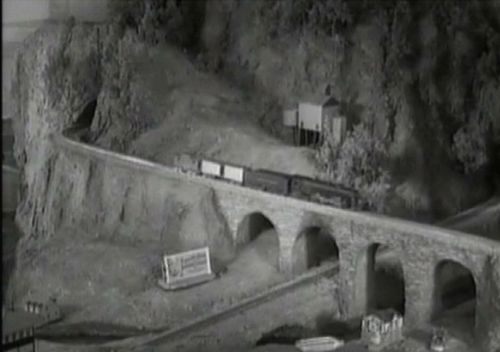
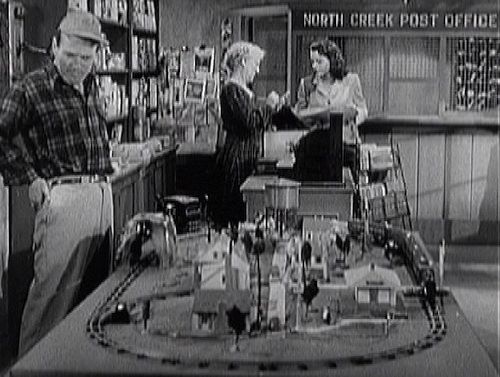
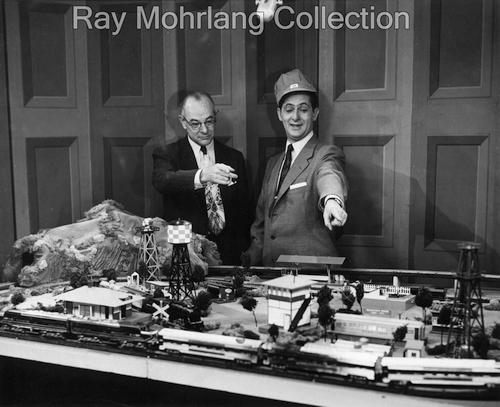
.Movie_Snapshot-500.jpg)
